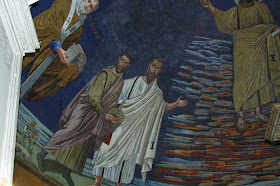
Wednesday of the Second Week of Lent.
Station at St. Cecilia's.
(S. Cecilia.)
 Interior of St. Cecilia's Basilica
Interior of St. Cecilia's BasilicaThe Station is at the sanctuary
where lies the body of
the illustrious Roman virgin St. Cecilia.
Originally the family mansion of St. Cecilia,
it was converted into a church
by Pope St. Urban in A.D. 230,
in accordance with her dying request.
Pope Paschal I restored it in 821.
In the fifth century this church was mentioned
as one of the most celebrated parochial or titular churches of Rome.
It is situated in the Transtevere.
St. Cecilia, Virgin and Martyr.
Suffered under Marcus Aurelius, A.D. 177
Her body was found to be perfectly incorrupt
when her coffin was opened in A.D. 821 and again in 1599.
St. Cecilia was a maiden of noble blood, born of parents of senatorial rank, and was brought up a Christian from her infancy, having a Christian mother. Her father must have been a pagan, for he gave her in marriage to a young patrician of very amiable and excellent dispositions, but a pagan, named Valerian.
St. Cecilia disclosed to her young husband Valerian, still a heathen, the secret of her virginity being specially consecrated to God, and being under the direct protection of an angel. Valerian expressed a wish to see the angel. Cecilia told him that he must first by Faith and the waters of Baptism be made a child of God, and that then his eyes would be unsealed and he would be permitted to behold her heavenly guardian. "There is an aged man," she said, "hiding in a certain place, who has power to cleanse men in the lustral water, and so make them worthy to see the angels."
 Mosaic of St. Valerian and St. Cecilia
Mosaic of St. Valerian and St. CeciliaValerian inquired: "where shall I find this old man?"
Cecilia replied: "Go as far as the third milestone on the Appian Way; there you will find some poor people who beg alms of the passers-by. I have always helped them, and they possess the secret. When you see them, salute them in my name, saying: "Cecilia has sent me to you, that you may lead me to the holy old man Urban, for she has charged me with a secret mission to him." Relate to him what I have told you (about the angel), and when he has baptized you he will clothe you with a new, bright garment, arrayed in which, when you enter this room, you will see the holy angel."
Valerian followed the Appian Way as directed, and at the third milestone, turning aside from the high-road to an old sand pit, he found some aged beggars and cripples lingering about; they were Christian watchers, set there to guard the secret entrance to the Catacombs, and to give notice of any soldiers, spies, or suspicious persons coming that way. Valerian was richly dressed, and his haughty bearing betrayed the heathen, but on his giving the required salutation and password, they led him into the subterranean depths, where he was instructed and baptized by Pope St. Urban.
 Valerian kneels before Pope St. Urban in the Catacombs.
Valerian kneels before Pope St. Urban in the Catacombs.Valerian, returning in the white robe of his baptism, and entering Cecilia's apartments to communicate to her the joy of his new-found faith, drew back astonished, awed by the bright light that streamed from her oratory as the curtain was drawn aside. There was Cecilia kneeling in prayer, and by her side an angel, whose face shone with ineffable beauty. Valerian, overcome with emotion, came and knelt on one side, Cecilia kneeling on the other, while the angel held forth two crowns of lilies twined with roses over the head of each.
 The angel held forth two crowns of lilies twined with roses over the head of each.
The angel held forth two crowns of lilies twined with roses over the head of each.
Valerian's brother Tiburtius was instructed and baptized soon after him. These two were presently martyred for refusing to offer sacrifice to the gods.
Cecilia alone remained, and as Almachius, the judge, thought it best that her punishment should be as secret as possible, he ordered that she should be shut up in the
Caldarium, or room of the warm bath in her own palace, and that the pipes with which the walls on all sides were perforated, should be heated to such a degree as to cause suffocation. Cecilia entered the room the furnace being heated, and although she remained there for a day and a night she was found to be unhurt by the hot steam that scalded those who opened the door.
 St. Cecilia condemned by Almachius
St. Cecilia condemned by AlmachiusAlmachius then sent for her to be beheaded. Three times did the axe fall upon her tender neck, inflicting deep and mortal wounds, but without severing the head. As the law did not allow more than three strokes to be given, the excutioner went away, leaving her still breathing and bathed in her own blood. For two days she continued hovering between life and death; and on the third morning the venerable bishop Urban came to take leave of his beloved daughter. Her dying request to him was, that the poor she had always loved should be cared for, and that her house should be made a church for ever.
 The crypt of St. Cecilia's
The crypt of St. Cecilia's


















































